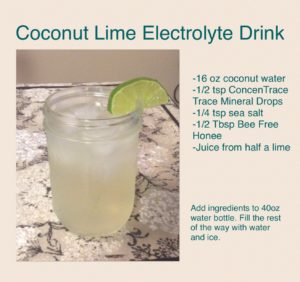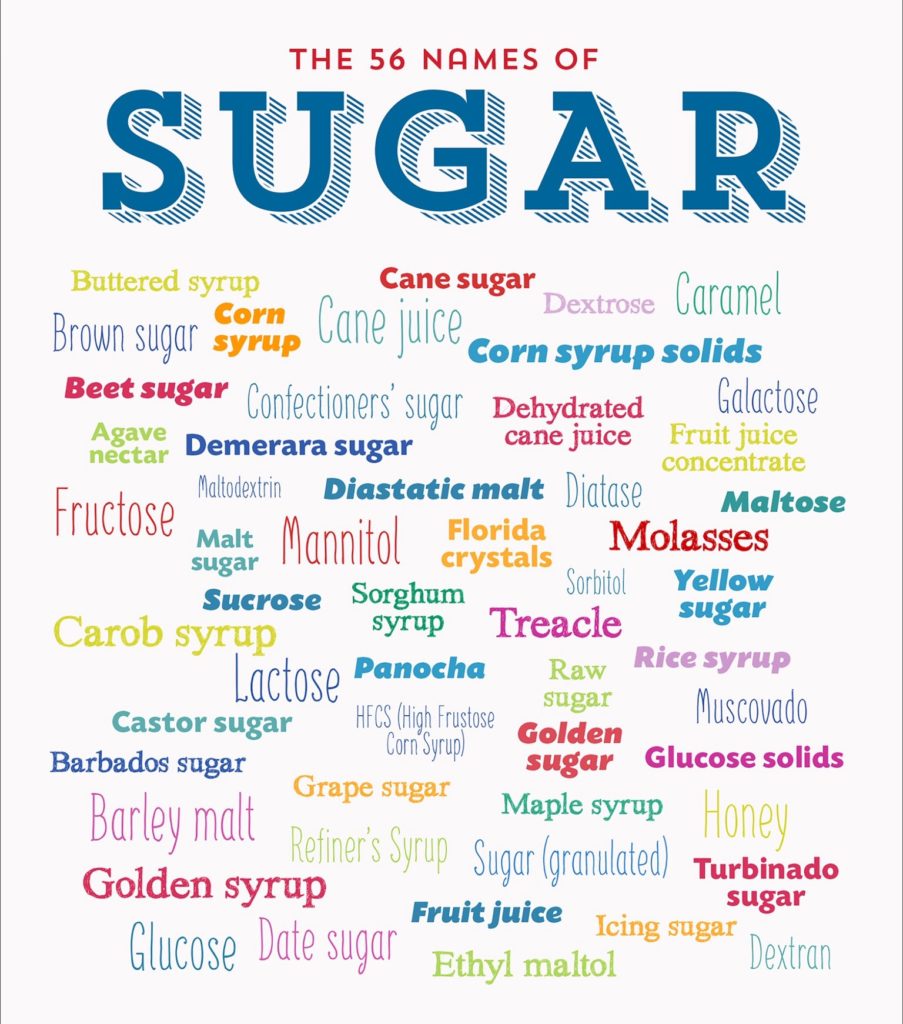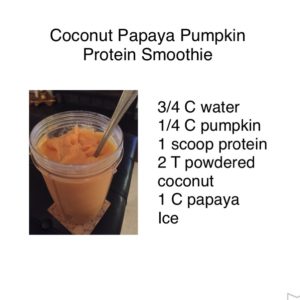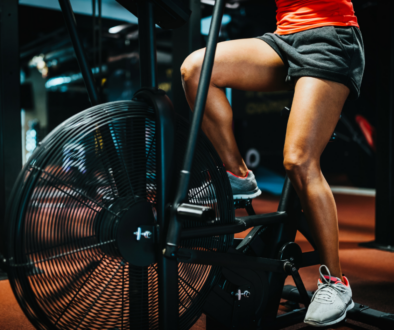Fix Your Nutrition in 10 Steps
You’re working out, going to yoga, using your foam roller, maybe even getting 8 hours of sleep. But how’s your nutrition?
Here are my 10 steps to fix your nutrition:
1. Water: Drink at least 100oz of water everyday. Caffeinated, sweetened, artificially sweetened, and alcoholics drinks do not count. Carry a water bottle with you everywhere. When you finish it, refill it. Count your refills to track your ounces. If it works for you, fill a large 100oz pitcher fill 4 or 5 BPA-free water bottles in the morning and work on finishing those throughout the day.

2. Breakfast: Start everyday with a healthy breakfast. This habit will jump start your metabolism and you’ll be more likely to keep the momentum going all day long. Aim for a 300-400 kcal breakfast with complex carbohydrates, healthy fat, and 20-30g of protein within 30-60 minutes of waking. Don’t like eating in the morning? Try a protein smoothie. Don’t have time? Meal prep the night before or make your breakfast for the week. Prepare meals that are easy to pack or to eat on the go.
3. Protein: Most people do not get enough protein. If weight loss is your goal, protein is key. A simple formula is 1g of protein for every 0.7lbs of body weight. A 150lb person would need 105g of protein daily. If you are training hard, you’ll need up to 1g of protein for every pound of body weight. Aim for 20-30g of protein with each of your 4-5 meals/snacks. Protein sources include: meat, eggs, dairy, tempeh, almond milk, nuts, seeds, legumes, and grains. A protein supplement once a day is a great way to make up the balance if you are not hitting your target.
4. Post-workout refuel: For weight loss, weight gain, strength or endurance goals, your post-workout meal needs be the biggest, most carbohydrate dense meal the day. If you are not eating within 30 minutes of your workout (strength or cardio), you are missing this window of opportunity. The calories from the post-workout meal will not be converted to fat storage as the protein and carbs will be used to rebuild and repair tissue and to replenish depleted energy stores. After a workout, muscles are primed and ready to absorb the nutrients. To determine the amount of protein needed, multiply your body weight in pounds by 20% (a 150lb person should aim for 30g of protein post-workout). Double that number to determine the minimum amount of carbohydrates needed (60g in this example). The harder and longer you work, the more calories from carbohydrates you’ll need. Keep the fat low as it slows digestion, which is the opposite of what we want in this meal.
5. Probiotics and Prebiotics: Probiotics are gut-friendly bacteria that help keep your digestive system working smoothly. In addition to finding them in supplement form, you also get these from eating cultured and fermented foods such as yogurt, kim chi, miso, tempeh, and sour kraut. The only forms of soy I recommend are the fermented miso and tempeh. Look for organic to avoid genetically modified soy. Did you know you also need prebiotics? Prebiotics provide the nourishing environment for the probiotics to flourish. These are found in asparagus, Jerusalem artichokes, bananas, oatmeal, honey, red wine, maple syrup, and legumes (beans, lentils, peanuts, and peas). The digestive system affects other systems such as the immune and endocrine (hormones) systems. If you are not taking care of your digestive system, this can leave you more susceptible to illness and injury, negatively affect sleep, and increase stress and inflammation. All these things affect your overall health and body weight. Add these pre- and probiotic rich foods to your diet daily to keep your digestive system and your whole body healthy.
6. Fiber: Aim for at least 30-40g of fiber per day. Most people do not get enough fiber because they are eating too many processed foods and not enough whole foods. Forget bars and cereals with added fibers, these are processed and probably have added sugars, flavorings, and preservatives. Get all the fiber you need from vegetables, fruit, grains, legumes, nuts, and seeds. Another benefit to logging in MyFitnessPal is that in addition to tracking your total calories and macronutrients (protein, fat, carbs), it also tracks your fiber! Eat a combination of raw and cooked vegetables everyday. Add roasted veggies to a salad of greens; add spinach or kale to your protein smoothie; snack on almonds, carrots, and hummus; substitute quinoa for pasta; add a can of lentils to any recipe you’re making for dinner, or add a ¼ to ½ cup of black beans to your salad at lunch. Experiment with different vegetables, join a co-op, eat colorful veggies, and last resort, keep frozen vegetables on hand and add them to any meal your already making.
7. Healthy Fats: Polyunsaturated Omega 6 (LA, GLA) are found in vegetable oils such as corn, safflower, canola, and soybean. Polyunsaturated Omega 3 (ALA, EPA, DHA) are found in salmon, flax, hemp, chia seeds, fish oil supplements, and vegetarian algae oil supplements. Omega 6 and Omega 3 should be consumed in a ratio of 1:1 or 2:1. Most Americans are typically consuming them at a ratio of 20:1. Monounsaturated Omega 9 (Oleic) are made by the body and also found in olive oil, avocados, macadamia, almonds, pecans, pistachios, and cashews. Good saturated fats, found in coconuts, are medium chain triglycerides (MCTs) which are more likely to be used for energy than stored as fat in the body. Perhaps you’ve heard of adding coconut oil to your morning coffee for the MCTs. Increase your daily intake of healthy fats by taking an Omega 3 supplement, snacking on nuts, topping a salad with hemp seeds, nuts, salmon, or avocado, mixing coconut, avocado, or chia seeds in your smoothie, or adding ground flax seeds to eggs, soup, stir fries, oatmeal, or stews. Read more about fat here.
8. You say CHEAT day, I say TREAT day. Whatever you call it: cheat day, treat day, refeed, or #vicefriday, earn it and enjoy it. You need this both for the psychological break and for the stimulating effect on your metabolism. Some rules to keep in mind:
- Find balance: If your week was filled with skipped meals, skipped workouts, junk food, and alcohol, it’s really not a treat day if you overdue it one more day over the weekend.
- Have your usual protein rich breakfast on your treat day. If, however, your splurge is breakfast, finish the day with a salad complete with protein and healthy fats.
- Do not skimp on water on your treat day.
- Do not stretch out your treat day over multiply days (i.e. dinner, drinks, and desert one night and brunch the next day). After your treat day, get a good night’s sleep and get back on your program the next day.
- Do not log or count calories this day.
9. Sugar: If you have been paying attention recently, you know that the obesity, diabetes, and CV disease epidemics that we are facing today are caused in large part by sugar. In the 1990’s we made the mistake of demonizing fat and replacing it with sugar and artificial sweeteners. Today we are paying the price. Americans are addicted to sugar, consuming an average of 20 teaspoons or 80g per day. How much is too much? The American Heart Association advises limiting daily ADDED sugar intake to 6 teaspoons for women and 9 for men (25 and 37g). ADDED sugars are sweeteners you add to foods, drinks, and recipes (sugar, honey, agave, brown rice syrup, etc), as well as sweeteners found on the ingredient labels of everyday foods like protein bars, ketchup, and flavored yogurt. NATURAL sugars are found in fruit, vegetables, grains, legumes, and dairy products, If you are tracking on MyFitnessPal, you’ll notice ADDED and NATURAL sugars are not tracked separately. Therefore, I prefer to use the World Health Organization’s guidelines: no more than 10% of total calories from ALL sugar. For a 2000 calorie diet, that would be no more than 200 kcals from sugar (50g or 12 tsp). I suggest no more than 2 servings of fruit each day, no fruit juice, and no dried fruit. Kick the sugar habit and you’ll be amazed at how much better you look and feel!

10. AVOID: Here it is, the dreaded no-no list. After adding all the water, protein, vegetables, fruit, nuts, seeds, and whole grains, hopefully you’ll be so full and satisfied that there won’t be any room for the bad stuff. But just in case, here’s a list of ingredients to eliminate from your diet:
-
High Fructose Corn Syrup: HFCS contains more fructose than glucose. Like fruit, it requires little digestion and goes straight to the liver. It spikes blood sugar and insulin levels. Insulin triggers cells to store fatrather than break it down for energy. As the liver gets saturated with glycogen, blood triglyceride levels increase. This increases the risk of CV disease and increases fat storage. This also contributes to the risk of high blood pressure. You won’t feel satisfied and after the inevitable ‘crash.’ You’ll be looking for a quick fix in the form of unhealthy snacks and the vicious cycle starts all over again.
-
Artificial Sweeteners: These are not the answer to your sugar cravings. Get off of these as soon as possible. They can sill increase blood sugar levels (setting off the same cycle of problems as with HFCS). Some sweeteners have been found to be neurotoxins and carcinogens.
-
Trans Fat aka Hydrogenated Oil: No amount of trans fat is acceptable in your diet. They raise LDL and lower HDL levels (exactly the opposite of what we want).
-
MSG: This chemical is given to animals in experiments to induce rapid weight gain as it disrupts the signal of feeling full in the brain. Maybe this is why it’s so easy to overeat Chinese take-out.
-
Nitrates: This is a preservative found in processed meats. It is a known carcinogen that the USDA banned in the 1970’s. Food manufactures vetoed because they had no safe alternative.
-
RBGH: A hormone given to cows to increase milk production. Avoid dairy products and whey protein supplements that do not explicitly state on the label that the product comes from cows not treated with RBGH.
-
Dyes: May contribute to behavior issues, especially in children. Some are known carcinogens that have been banned in other countries and in the U.S. but companies are allowed to use it if it’s in their current supply.
-
Potassium bromate, or bromated flour, Brominated oil, BHA, BHT: Preservatives and flavorings banned in other countries.
-
GMO’s: Whenever possible, purchase organic or foods labeled as non-GMO. It’s better for you, the environment, the animals, and the workers handling your food.
-
Any foods to which you are allergic, sensitive, or intolerant: be aware of how certain foods make you feel after eating them or the next day.
Have you found some areas to work on? Here’s how to use this list:
- You can’t manage what you don’t measure. Get a good day of logging in MyFitnessPal to see where you’re at currently. Continue to log daily to stay on track and meet your goals. Learn how to set up MFP here.
- Pick one step to work on at a time.
- Start by adding nutritious foods to your diet, rather than taking foods away.
- Make a list and purchase the foods you want to add and the supplies you’ll need. Check out my Grocery List and Shopping List for suggestions. Make it as simple as possible. Buy foods you will actually prepare and eat.
- Some of these may need to be broken down in smaller steps: If you aren’t drinking much water, start with a goal of 60oz, then 80oz, then 100oz. If you are a sugar addict, start by swapping out one sugary snack/drink at a time.
- The tougher the change, the more time it takes to solidify into your routine. Dedicate one to six weeks to making new habits.
- Use apps like Way of Life or Coach.me to create new healthy habits.
Don’t know where to start? Need accountability? I can help! Email me to start Nutrition Coaching today!
Alicia Cross is a Certified Personal Trainer, Wellness Coach, and Yoga Instructor with more than 15 years’ experience working with clients in classes and one-on-one. She is a yogi, meditator, vegan, and lifter of heavy things. If you’re ready to discover the strength and peace that comes from within, email Alicia@AliciaCrossTraining.com.
Related Posts:
You Can’t Out-Exercise a Bad Diet
8 Ways to Get More Plant-Based Protein
Ten Tips for Eating Healthy While Traveling




